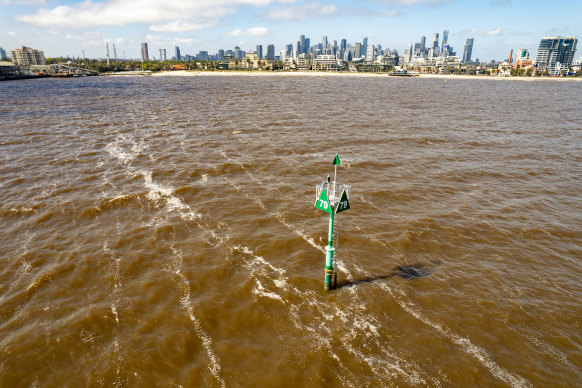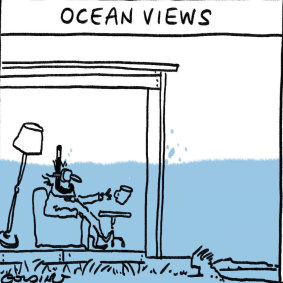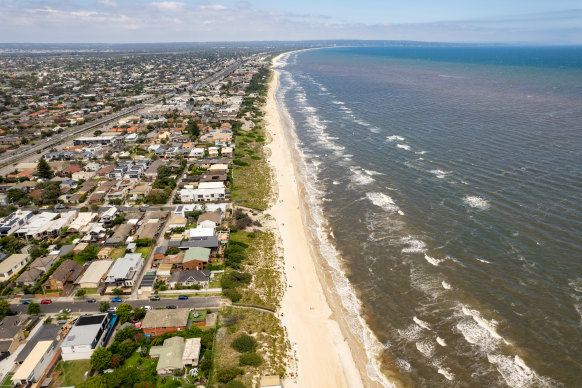This was published 10 months ago
The suburbs most under threat from rising seas revealed
By Royce Millar and Benjamin Preiss
The full risk to homes, infrastructure and beaches right around Port Phillip Bay from sea-level rise and storm surges linked to climate change has been revealed in confidential government studies that lay bare the multibillion-dollar challenges facing bayside communities and the environment.
Almost six years after the government commissioned work on its Port Phillip Bay Coastal Hazard Assessment, it has finally released research mapping out the likely impacts on the 310-kilometre shoreline.
It warns the effect of the higher sea level would be amplified by stronger tides, bigger waves and changes in the level of groundwater.
That combination of events would fuel a tenfold increase in inundation, with almost five square kilometres in central Melbourne – including in Docklands, Southbank and Fishermans Bend – at risk in a scenario of sea level rise of 1.4 metres by 2100 and during a one-in-100 chance event.
Selected bayside council heads and others were briefed on the studies’ general findings on Tuesday, the day the government released key documents to The Age through freedom of information, including commercial-in-confidence research by the CSIRO that was commissioned in 2019 and completed in 2022.
The hazards studied included the impacts of sea-level rise, inundation, erosion and rising groundwater levels, factoring in storm surges and wave height, in the most comprehensive analysis to date of the risk of climate change to communities, assets and the natural environment around the bay, including Geelong.

Port Phillip Bay on Wednesday, after recent rains across the state.Credit: Jason South
“Victoria’s precious coastline is already being impacted by climate change. Our focus is on managing the risks, adapting to the changes, and supporting communities and industries to be resilient,” Environment Minister Steve Dimopoulos said in a statement.
The findings provide the basis for potentially controversial and politically sensitive inundation overlays to guide development, but also discussions about what infrastructure – and possibly housing – may need to be abandoned or relocated.
Areas identified as especially vulnerable include Point Lonsdale, Queenscliff and Portarlington to the south-west of the bay; Werribee and Altona to the north-west; Southbank, Port Melbourne and Elwood in the north; and Mordialloc, Patterson Lakes and Martha Cove to the south and south-east.
In its final report for the government, the CSIRO notes that the most “extensive hazard zones” are in low-lying parts of the western side of the bay including around Point Henry, Point Lillias, the strip between Little River and the Werribee River, and further north along the Altona and Williamstown foreshores.
But more sensitive – including politically – is the area to the east and south where there are expensive homes in swinging seats.
The CSIRO report says rising sea levels will likely reduce the effectiveness of existing, ageing structures that have artificially modified the coastline since European settlement such as seawalls, marinas and beach renourishment (trucking in sand).
It also warns that while the narrow entrance to the bay, through the heads, has restricted tidal flows, rising seas will reduce that effect, amplifying the impact of sea-level rise.
While the City of Melbourne has limited coastline and significant “protective structures” such as seawalls, the CSIRO found that at sea-level rise of 1.4 metres by 2100, the effectiveness of seawalls would be reduced. The area at risk of inundation in a one-in-a-100 chance event would expand tenfold to take in almost five square kilometres of the central city, including parts of Southbank and Fishermans Bend.
In the City of Port Phillip, the area at risk would increase almost fivefold to about seven square kilometres.
Further south, the inundation hazard increased tenfold to 4.4 square kilometres. Much of the increase would be around the Edithvale-Seaford Wetlands between Mordialloc Creek and Patterson River, with the CSIRO concluding that at 1.4 metres sea-level rise, existing coastal protective structures would not be effective.
On the Mornington Peninsula, inundation at 1.4 metres sea-level rise would centre on Martha Cove and along the foreshore from Rosebud to Dromana.

Credit: Illustration: Matt Golding
The CSIRO report notes that the primary hazard faced by coastal communities worldwide is sea-level rise. The level at which it is forecast is crucial to the assessment of the hazard.
The state government has not updated its planning benchmark for sea-level rise since 2008 when it first incorporated the then-upper-end projections of the Intergovernmental Panel on Climate Change (IPCC) for at least a 0.8-metre sea-level rise by 2100.
But since then, researchers have found the Victorian coast is also being pounded by waves from a more southerly direction and of increasing height, especially during storms.
In 2019, the IPCC revised its projections – factoring in ice melt – and found that inaction on climate change would likely result in sea-level rise of 1.1 metres by 2100. It continues to update its projections.
Several other states are already planning for larger increases in sea levels.
NSW is anticipating increases of up to 1.06 metres based on IPCC data and depending on action to limit greenhouse gas emissions. South Australia is planning for an increase of 1 metre.
The Port Phillip project modelled sea-level rise across a range of forecasts from 0.8 to 1.4 metres. A well-placed source, speaking anonymously to discuss confidential information, said the government was preparing to update its sea-level rise forecasts in line with IPCC’s in the first half of this year.
Dimopoulos said the Port Phillip hazard-assessment work would be used to help councils and communities “better understand, plan for, and manage the increasing impacts of climate change on our coastal environments”.
University of Melbourne geomorphologist Professor David Kennedy said councils should not be left with the expensive and politically fraught task of turning the research into planning rules.
“For something of this critical importance, at a minimum, planning at state level is needed to provide the guidelines from which local planners can assess future development proposals,” he said.
“In an ideal world this should be undertaken at a federal level – the issue of climate change does not stop at state boundaries or local boundaries.”
The Port Phillip work follows the release of a related study last year by University of Melbourne professor of environmental economics Tom Kompas, who has described sea-level rise as the “biggest risk to the Australian economy from climate change” – above bushfires, heat stress and the damage to agriculture.
Kompas found that Victoria faced property damages reaching $337 billion in present value by 2100, with more than 80,000 current residential, commercial and industrial properties likely affected by sea-level rises and storm surges by 2100.

The coastline at Chelsea in Melbourne’s south.Credit: Jason South
The losses to wetlands would reach a further $105 billion over the same period, bringing the total to $442 billion.
Get alerts on significant breaking news as happens. Sign up for our Breaking News Alert.